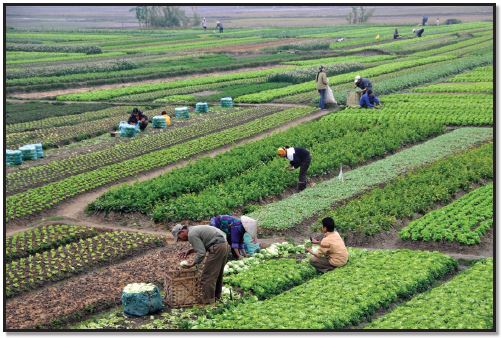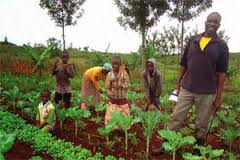The Duty of Modern Technology in Commercial Farming vs Subsistence Farming Approaches
The Duty of Modern Technology in Commercial Farming vs Subsistence Farming Approaches
Blog Article
Examining the Technical Innovations Transforming Precision Farming Today
As the agricultural market grapples with the challenges of feeding an expanding population and making sure sustainability, technical technologies are reshaping the landscape of precision farming. The complete impact of these advancements on standard farming techniques and their long-lasting sustainability remains a topic ripe for expedition.
Drones in Farming

Drones facilitate accurate tracking of huge farming stretches, identifying areas needing interest, such as parasite invasions or nutrition deficiencies. This targeted method permits the optimized application of plant foods, pesticides, and water, reducing waste and environmental influence. Drones dramatically decrease the time and labor traditionally required for area inspections, enhancing performance and reducing functional expenses.
Beyond data collection, drones are important in precision growing and plant splashing, making sure consistent circulation and decreasing ground disruption. The assimilation of drones right into agriculture exhibits a change in the direction of data-driven farming methods, where innovation not only increases typical methods but likewise introduces innovative services for future obstacles. As the agricultural industry deals with stress from climate change and populace growth, drones provide an encouraging avenue for lasting accumulation and source conservation.
Satellite Images Advancements
While drones have actually substantially enhanced accuracy farming via airborne information collection, satellite imagery remains to play a crucial role in widening the range and range of agricultural surveillance. Satellite innovation offers substantial protection, making it possible for farmers to gain access to vital insights over considerable locations, which is not feasible with drone modern technology alone. This is especially valuable for massive farms that require detailed, regular data.
Breakthroughs in satellite imagery have caused substantial improvements in resolution and frequency of data capture. Modern satellites can currently provide imagery with resolutions as great as 30 centimeters per pixel, permitting for comprehensive analysis of plant wellness, soil conditions, and irrigation patterns. In addition, the frequency of satellite passes has increased, guaranteeing that farmers can receive updated info frequently. This prompt data is essential for making notified, real-time choices to optimize crop yields and source usage.
In addition, the assimilation of multispectral and hyperspectral imagery has actually improved the information top quality, enabling the precise identification of plant species, development stages, and stress and anxiety elements. With artificial intelligence formulas, farmers can translate satellite information a lot more successfully, projecting plant performance and prospective problems with unprecedented precision. These innovations are essential in enhancing lasting farming methods internationally.
IoT in Farming
The development of the Web of Things (IoT) in farming stands for a standard shift in agricultural monitoring techniques, supplying exceptional connectivity and data-driven understandings. As IoT gadgets proliferate throughout farmland, they supply real-time monitoring and control over numerous agricultural processes. These clever tools, that include soil sensors, climate terminals, and livestock radar, gather and transmit information to central systems, allowing farmers to make informed choices and optimize source usage.
IoT modern technology assists in accuracy farming by boosting the accuracy of information collected from the field. For example, dirt wetness sensing units can find variations in wetness levels, permitting specific irrigation organizing, which conserves water and promotes much healthier plant growth. Environment sensing units offer essential information on temperature level and humidity, assisting in bug and disease administration through prompt treatments.
Additionally, IoT-enabled machinery, such as self-governing tractors and drones, further enhance operations by automating labor-intensive jobs and reducing human mistake. These advancements not only boost performance but likewise contribute to sustainability by minimizing inputs like water, plant foods, and pesticides. As IoT proceeds to progress, its integration into farming techniques will likely strengthen, driving performance and sustainability in the farming market.
AI-Driven Analytics
Structure upon the robust information collection capacities of IoT, synthetic intelligence (AI) arises as a powerful device in changing raw data right into workable insights for accuracy farming. AI-driven analytics leverages maker knowing algorithms to assess substantial datasets gathered from satellites, sensing units, and drones.

In addition, AI-driven analytics sustain accuracy farming website here by supplying tailored referrals for planting routines and watering administration. These insights help enhance water usage, lining up with sustainability objectives. By delivering real-time insights and critical guidance, AI-driven analytics not only boost functional efficiency however likewise contribute in the direction of sustainable farming techniques, protecting food supply chains for the future.
Robotics and Automation
In the realm of precision farming, robotics and automation are transforming agricultural practices by providing unmatched performance and accuracy - commercial farming vs subsistence farming. These innovations are increasingly being integrated right into different farming processes, from planting and gathering to tracking and upkeep. Automated systems, such as self-governing tractors and robot farmers, enable the optimization of labor-intensive tasks, decreasing human mistake and labor prices. These makers are geared up with gps and sensing units innovation, allowing them to operate with high precision and adjust to varying field conditions.
Additionally, robotic systems enhance plant monitoring and management. Drones equipped with imaging innovation can evaluate huge areas swiftly, giving real-time data on plant health and soil problems. This details is crucial for making notified decisions relating to irrigation, fertilizing, and pest control, therefore improving yield and resource performance. In addition, robotic weeders and planters boost the accuracy of these tasks, resulting in more efficient use inputs.
The combination of robotics and automation in accuracy farming likewise addresses sustainability problems (commercial farming vs subsistence farming). By maximizing inputs and optimizing outputs, these modern technologies help reduce environmental influence. Consequently, robotics and automation not just change agricultural efficiency however also contribute dramatically to sustainable farming techniques.
Verdict
Technical advancements are fundamentally reshaping image source precision farming by integrating advanced tools like drones, satellite imagery, IoT tools, AI-driven analytics, and robotics. Robotics better enhance operations, leading to set you back decreases and boosted performance, eventually changing standard farming methods.
Revolutionizing the farming landscape, drones have actually arised as a pivotal tool in precision farming.IoT modern technology assists in precision farming by enhancing the accuracy of data gathered from the area.Building upon the durable information collection capabilities of IoT, artificial knowledge (AI) emerges as a powerful tool in changing raw information right into actionable insights for accuracy farming.In the world of accuracy farming, robotics and automation are transforming farming methods by providing unmatched performance and precision.Technological advancements are essentially improving accuracy farming by integrating innovative tools like drones, satellite images, IoT gadgets, AI-driven analytics, and robotics.
Report this page